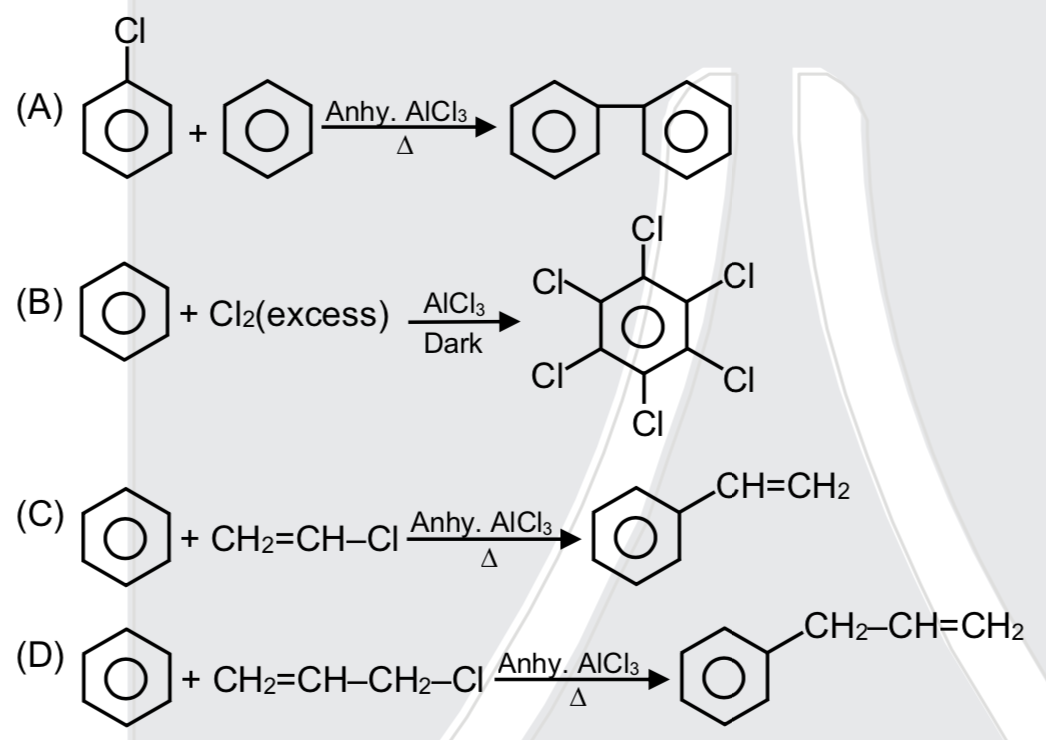Which of the following reaction is possible at anode ?
2Cr3++7H2O→Cr2O2−7+14H+
F2→2F−
(1/2)O2+2H+→H2O
None of these
The correct Answer is:A
To determine which of the given reactions is possible at the anode, we need to remember that the anode is the electrode where oxidation occurs. Oxidation is defined as the loss of electrons. Let's analyze each of the options provided to identify which reaction involves oxidation.
1. Understand the Role of Anode:
- The anode is the electrode where oxidation takes place. Oxidation involves the loss of electrons.
2. Analyze Each Reaction:
- Option 1: 2Cr3++7H2O→Cr2O2−7+14H+
- In this reaction, the chromium ions (Cr3+) are being converted into dichromate ions (Cr2O2−7).
- To balance the charges, we see that the total charge on the products is +14 (from 14H+) and −2 (from Cr2O2−7), giving a total of +12. The reactants have a total charge of +6 (from 2Cr3+).
- This indicates that 6 electrons are released, confirming that this is an oxidation reaction. Thus, this reaction is possible at the anode.
- Option 2: F2+2e−→2F−
- Here, fluorine (F2) is gaining electrons to form fluoride ions (F−).
- Since this reaction involves the gain of electrons, it is a reduction reaction. Thus, this reaction occurs at the cathode, not the anode.
- Option 3: H2+2H+→2H2O+2e−
- In this case, hydrogen gas (H2) is reacting with protons (H+) to form water.
- This reaction also involves the gain of electrons, indicating that it is a reduction reaction. Thus, this reaction also occurs at the cathode, not the anode.
3. Conclusion:
- After analyzing all the options, we find that only Option 1 represents an oxidation reaction, which is possible at the anode.
Final Answer:
The reaction that is possible at the anode is Option 1: 2Cr3++7H2O→Cr2O2−7+14H+.
- The anode is the electrode where oxidation takes place. Oxidation involves the loss of electrons.
- Option 1: 2Cr3++7H2O→Cr2O2−7+14H+
- In this reaction, the chromium ions (Cr3+) are being converted into dichromate ions (Cr2O2−7).
- To balance the charges, we see that the total charge on the products is +14 (from 14H+) and −2 (from Cr2O2−7), giving a total of +12. The reactants have a total charge of +6 (from 2Cr3+).
- This indicates that 6 electrons are released, confirming that this is an oxidation reaction. Thus, this reaction is possible at the anode.
- Here, fluorine (F2) is gaining electrons to form fluoride ions (F−).
- Since this reaction involves the gain of electrons, it is a reduction reaction. Thus, this reaction occurs at the cathode, not the anode.
- In this case, hydrogen gas (H2) is reacting with protons (H+) to form water.
- This reaction also involves the gain of electrons, indicating that it is a reduction reaction. Thus, this reaction also occurs at the cathode, not the anode.
- After analyzing all the options, we find that only Option 1 represents an oxidation reaction, which is possible at the anode.
The reaction that is possible at the anode is Option 1: 2Cr3++7H2O→Cr2O2−7+14H+.
Topper's Solved these Questions
- ELECTROCHEMISTRYBook:NCERT FINGERTPS ENGLISHChapter:ELECTROCHEMISTRYExercise:HOTS
Explore 10 Videos
- ELECTROCHEMISTRYBook:NCERT FINGERTPS ENGLISHChapter:ELECTROCHEMISTRYExercise:EXEMPLAR PROBLEMS
Explore 17 Videos
- COORDINATION COMPOUNDS Book:NCERT FINGERTPS ENGLISHChapter:COORDINATION COMPOUNDS Exercise:Assertion And Reason
Explore 15 Videos
- GENERAL PRINCIPLES AND PROCESSES OF ISOLATION OF ELEMENTSBook:NCERT FINGERTPS ENGLISHChapter:GENERAL PRINCIPLES AND PROCESSES OF ISOLATION OF ELEMENTSExercise:Assertion And Reason
Explore 15 Videos
Similar Questions
Knowledge Check
Which of the following reactions takes place at anode ?
AReductionBOxidationCDecompositionDDissolution
Which of the following reactions are possible ?

View SolutionWhich of the following compound is possible :
View SolutionWhich of the following reactions is / are possible at the anode ?
View SolutionWhich of the following reactions occurs at the anode during the recharging of lead storage battery ?
View SolutionWhich of the following arrangement is possible ?
View SolutionWhich of the following configuration is not possible ?
View SolutionWhen electrolysis of silver nitrate solution is carried out using silver electrodes, wich of the following reaction occurs at the anode?
View Solution